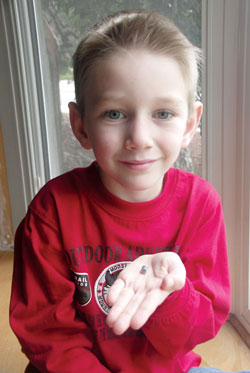February 5, 2008 - By Krista Conger

Braden Eberle, 4, had a toy with a magnet in his mouth when it got loose and slipped down his throat. When it happened a second time, he got a stomachache.
Four-year-old Braden Eberle was worried. 'Mom, I swallowed something,' said the San Jose boy. His mother, Jill, reassured him when she learned that it was just a tiny magnet that had slipped loose from a construction-type toy. But the next day, he swallowed another.
'I didn't think anything of it at first,' said Jill Eberle, but she threw away the toy set after the second incident. Braden had put the pieces in this mouth when the pencil eraser-sized magnets came loose and slipped down his throat. 'They were so tiny, I thought they would just pass through.'
The next day, Friday, Braden began to complain of an intermittent stomachache severe enough to wake him from sleep. On Saturday morning, Eberle took her son to the emergency room - purely as a precautionary measure. 'I thought it was probably the flu, but I couldn't stop thinking about the magnets,' Eberle said.
'Braden didn't really look that sick,' agreed Lucile Packard Children's Hospital pediatric surgeon Sanjeev Dutta, MD, who evaluated Braden at Good Samaritan Hospital in San Jose in April 2007. (Lucile Packard Children's Hospital provides pediatric surgical services to Good Samaritan.) 'But when I heard he'd swallowed two magnets at two different times, I became concerned.' X-rays revealed that the powerful rare-earth magnets had snapped together in Braden's intestinal tract and were pinching the delicate tissue. Braden needed immediate surgery.
'Dr. Dutta was adamant,' said Eberle, who hadn't expected such a drastic response. 'He wasn't messing around.' Within two hours, the surgery was over. Dutta used minimally invasive laparoscopic techniques to remove the magnets through three small incisions, and Braden recovered quickly.
Dutta described the case in a study published in the February issue of the Archives of Pediatric and Adolescent Medicine as a cautionary tale for other physicians. The report urged clinical vigilance and early surgical consultation when magnets are swallowed - even if the child exhibits few symptoms of distress.
Many of the magnets in toys made today contain neodymium, a metal with an unusually strong magnetic force.
'These rare-earth magnets are so much more powerful than the magnets we used to play with as kids,' said Dutta, who is also an assistant professor of pediatric surgery at the School of Medicine. 'Kids swallow things all the time. Even one magnet can cause a problem if the child has swallowed something else made of metal.'
Intestinal tissue pinned between the objects can disintegrate, causing an infection or digestive problems. Also, the affected length of intestine can become twisted, cutting off the blood supply and killing that portion of the bowel.
'The fact that kids have died or gotten very sick from swallowing these magnets is a big concern to me, and a primary reason why I wanted to publish Braden's case,' said Dutta. 'These magnet toys are ubiquitous. They're recommended for older children, but many of these kids have younger siblings.' Braden had been playing with his older brother's set.
Older children may also be at risk. Less than two weeks after Braden's surgery, the Consumer Product Safety Commission (http://www.cpsc.gov) issued an update to an earlier warning about toys containing magnets like those Braden swallowed. At that time, one death and 27 intestinal injuries like Braden's had been reported due to such magnets. At least 10 of those injuries involved children between the ages of 6 and 11.
Several magnet-based construction sets have been recalled by the commission. In many, the tiny, powerful magnets are affixed to plastic building pieces such as 1.5-inch squares, 1-inch triangles, cylinder rods, flexors, connectors, x-tenders and curves. The sets come in an assortment of colors. Other types of toys and games with the magnets have been subjected to similar recalls during the past year.
'I can't believe they use these magnets in children's toys,' said Eberle, who has banned all such magnets from her house. That is, all but two - the two Dutta removed from Braden's intestine. Those she keeps as a reminder of what could have happened.
'The fact that Braden knew to tell me he had swallowed something may have saved his life,' she said. 'I never would have known. I would have assumed it was the flu. It's so scary how it happens so fast.'
About Stanford Medicine
Stanford Medicine is an integrated academic health system comprising the Stanford School of Medicine and adult and pediatric health care delivery systems. Together, they harness the full potential of biomedicine through collaborative research, education and clinical care for patients. For more information, please visit med.stanford.edu.